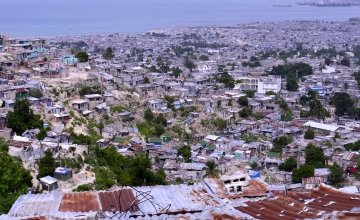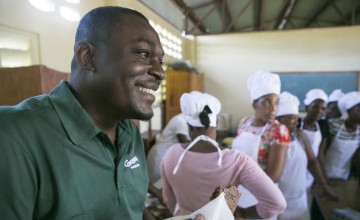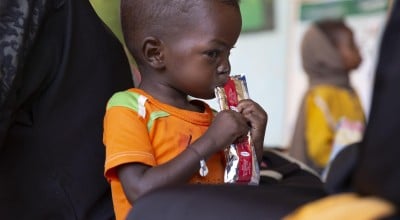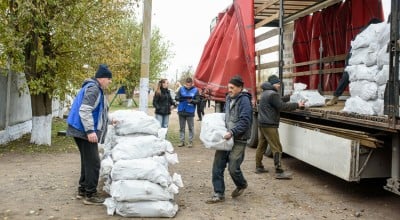
Read our 2024 annual report

Knowledge Hub
This weekend marks 10 years since a powerful earthquake rocked the already vulnerable island nation of Haiti. This was one of the world’s largest natural disasters on record and hit close to the densely populated capital city of Port-au-Prince.
Never before had the world seen an earthquake of this magnitude strike an urban setting. The impact was colossal.
More than 230,000 people were killed, including a quarter of the country’s civil servants. A further 300,000 people were injured. Buildings had collapsed all over the city, leaving 1.5 million people homeless.
I will never forget arriving into Port au Prince just after the earthquake struck.
The destruction was everywhere. Dead bodies lay on the streets and people wandered aimlessly around. It was like a bomb had dropped on the city.
My immediate thought was, where the hell do we start? To be honest I really wasn’t sure; that is until I got to the Concern office, which was miraculously still standing. Upon arrival, I met 20 of our Haitian staff.
Many had lost homes, family, friends, some were sleeping on the streets and yet, within 24 hours, they had showed up in their Concern t-shirts. When Wilkins, our head driver declared: “we’re here, alive and ready to work”, I knew that the spirit of the people of Haiti had not been destroyed. It was stronger than any earthquake.

Mass distributions
In the following days and weeks, supported by a massive public response, we mounted Concern’s largest emergency response in decades, pulling in everything we had. Within 24 hours, six charter planes of relief supplies were ordered and the first was being loaded.
Forty of our most experienced emergency staff were despatched, among them an expert on Google mapping to pinpoint where the more than one million displaced were living across the city. Hundreds of local staff were recruited and trained on how to do mass distributions.
Within a very short time, we had created a massive safety programme that supported and protected over 130,000 thousand people with clean water, shelter, cash for work, and grants for women to re-start small businesses, as well as establishing a network of nutrition centres and temporary classrooms across the city for thousands of children.
Earthquakes don’t just destroy buildings and livelihoods; they strip away the very fundamentals of dignity, safety and security.
Having survived, women and young girls in displaced sites across the city were increasingly being attacked at night. At an abandoned football stadium, Paul McCallion, an electrician from Donegal worked day and night to reconnect the stadiums flood lights.
When the lights were switched on, the most enormous cheer rose as thousands of women came out of the huts and danced and cheered. For the first time since the earthquake they felt safe.

Resilience is not inexhaustible
Haitians have extraordinary resilience, honed through struggle and hardship.
It was, after all the first independent nation of Latin America and the only nation in the world established following a successful slave revolt.
It is this inherent fighting spirit that has enabled people to withstand enormous challenges thrown at them. But resilience is not inexhaustible, nor inevitable and many more struggled enormously just to survive.
Now, 10 years on, the country is still deeply impoverished and in recovery. In the year after the earthquake, a cholera epidemic, traced back to the negligence of UN peace keepers, resulted in nearly 10,000 deaths.
Hurricane Sandy followed a year later and before communities could recover, the country was hit by Hurricane Matthew which devastated the agricultural sector.
More recently political unrest, inflation and persistent drought have magnified the ongoing threats the population is facing.
Concern has continued throughout, working with the most vulnerable communities implementing projects supported by Irish Aid and the European Union that reduce the risks to natural disasters.
The work includes construction of strong shelters, supporting community leaders in disaster preparedness and educating schoolchildren on what to do when a disaster strikes.
Not enough is being done
Together, with improved Government policy, such as superior building standards and better land-use planning, these interventions aim to reduce the human and financial impact of climate shocks.
However not enough is being done and, despite the fact that Haiti is the region’s most vulnerable country to climate change, it remains one of the least well prepared.
Our own annual budget is a fraction of what it was a number of years ago and the sum total of donor investment is grossly insufficient.
In 2018, the UN appeal for Haiti was funded at just 13 per cent which made it the most under-funded humanitarian crisis in the world.
Last year it reached only 32%. This ticking humanitarian time bomb has gone largely unnoticed. The lack of interest, action and funding is shameful.
In 2010, the world responded to the earthquake’s devastation with speed and extraordinary generosity, but now this country is in no way properly prepared for the next one. And it will come.
Prevention is key. After all earthquakes don’t kill people – poorly constructed buildings do. It was the ramshackle buildings that claimed thousands of lives when they buckled and crumbled. Building can be built back, lost lives cannot.
We can and should do so much more to protect the people of Haiti.
Other ways your company can get involved
Partnering with us
When you partner with us the results are transformational - for your business and the beneficiaries we work with.
Staff fundraising
From bake sales to coffee mornings and beyond – staff fundraising is a great way to foster team spirit while raising money for our life-saving work.
Concern gifts
Make a lasting difference by purchasing one of our six lifesaving Christmas gifts.
Payroll giving
Donate directly through your salary – an easy and efficient way to support our work.




